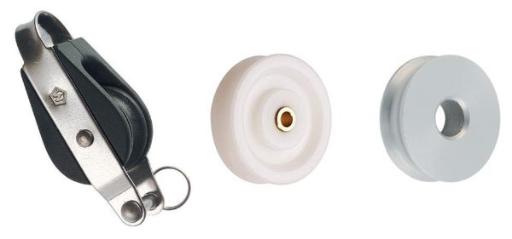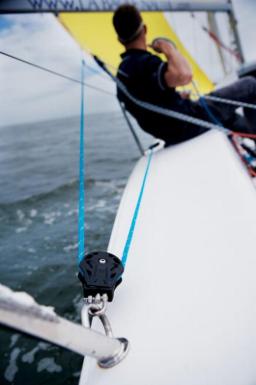When it comes to selecting the right block for a sailing application, the choice often comes down to three broad bearing types: plain bearing, ball bearing, and needle bearing. Each has its strengths and weaknesses, suited to different loads, line speeds, and duty cycles. In this article, we take a closer look at plain bearing blocks—the most basic but often the most robust option in a sailboat’s hardware toolkit.
What is a Plain Bearing Block?
A plain bearing block (also known as a bush bearing block) relies on a low-friction interface between the sheave and the axle, typically using a sleeve or bushing made from polymer or composite material. Unlike ball or needle bearing designs, there are no rolling elements—friction is managed purely through the contact between materials. This results in a simple, robust system that excels under high static loads, low-speed operation, and in contaminated or abusive environments.

It’s a common misconception that plain bearing blocks are somehow “old-fashioned” or only suitable for basic applications. In reality, modern materials science has significantly advanced the performance envelope of these blocks. Contemporary manufacturers—such as Morfrac, with their Morfblock series—are reimagining plain bearing blocks using precision-machined high-modulus composites and hybrid polymer formulations. These are engineered to:
- Reduce friction coefficients to approach that of more complex bearing systems.
- Increase load capacity through stronger, more dimensionally stable materials.
- Resist deformation or wear even under sustained static compression and environmental exposure.
Some plain bearings now incorporate fibre-reinforced polymer blends or ultra-low-friction acetals, fine-tuned to provide predictable performance under high load without lubrication, and with negligible wear over time. These aren’t just simple bushings—they’re the result of advanced tribological engineering, often outperforming traditional designs in the real-world conditions seen aboard cruising and offshore yachts.
In short, far from being outdated, plain bearing blocks represent a parallel path of innovation in sailing hardware—one that prioritises strength, durability, and minimal maintenance over high-speed rotational efficiency.
Plain Bearing vs Ball and Needle Bearings
Feature | Plain Bearing | Ball Bearing | Needle Bearing |
Best for | Static and high loads | Fast-moving and low loads | High-speed and high-load dynamic systems |
Friction at speed | Moderate to high | Very low | Low |
Durability | Very high | Moderate | High |
Maintenance | Low | Moderate | Moderate to high |
Cost | Typically lower | Moderate | Higher |
It’s important to understand that “better” is context-specific. A plain bearing block won’t spin freely under no load like a ball bearing block—but it will keep working long after a ball bearing block has suffered deformation or bearing wear from constant static tension.
Key Features of Plain Bearing Blocks
High Load Capacity
Because the load is spread across a wide contact surface between the sheave and the bearing surface, plain bearing blocks can handle very high loads without risk of brinelling (permanent indentations in bearing races). This makes them ideal for halyards, reefing lines, and heavy sheet loads on larger cruising yachts.
Durability in Harsh Environments
Plain bearings are usually constructed from UV-stable polymers, acetal or composite materials that perform reliably even when contaminated with salt, sand, or debris. With no rolling elements to seize, they are exceptionally resistant to dirt ingress and require very little maintenance over time.
Simplicity of Construction
The minimalist internal structure of a plain bearing block translates into fewer points of failure, particularly under extreme load or misalignment. This simplicity also typically results in a more compact and robust block, better able to tolerate shock loads and misaligned runs.
Cost-Effective Performance
For budget-conscious cruisers and riggers, plain bearing blocks offer a very good performance-to-price ratio, especially in applications where free-running sheave rotation is not critical.
Wichard Plain Bearing Blocks
Typical Applications for Plain Bearing Blocks
Halyard Turning Blocks
Where the line is under constant tension and moves only during hoisting and dousing, plain bearing blocks are a natural fit. They withstand the compression loads without bearing fatigue.
Mainsheet and Genoa Sheet Leads
Particularly on larger cruising yachts, where winch-assisted trimming means the block rarely sees high-speed rotation. The slow movement under load suits plain bearing geometry well.
Reefing Systems
These blocks often operate in harsh environments with limited movement but high loads. Plain bearings shine in these situations, as they’re resistant to wear and don’t suffer from salt crystal intrusion.
Boom Vangs and Tack Lines
Lines under high compression and intermittent adjustment benefit from the simplicity and toughness of plain bearing blocks.
When Not to Use Plain Bearings
Despite their strengths, plain bearing blocks are not ideal for high-speed, low-load applications like spinnaker sheets or control lines on racing dinghies. Here, a low-friction, high-efficiency bearing is essential for responsiveness and ease of trimming. In such cases, ball bearing or needle bearing blocks are a better fit.
Conclusion on Plain Bearing Blocks
Plain bearing blocks are the workhorses of sailing hardware: strong, durable, and unfussy. They may lack the silky-smooth rotation of their ball bearing cousins, but what they offer in return is robustness and reliability in the most demanding static and high-load applications.
For the cruising sailor, offshore passage-maker, or any application where toughness trumps speed, a plain bearing block might be the right tool for the job. As always, choosing the right block involves understanding your specific load cases, line speeds, and environmental factors—and plain bearings continue to earn their place on deck thanks to their unique set of strengths.
If you still have any questions, please feel free to talk to one of our sailing experts by contact us or to see our full range, please click below:



Plain Bearing Blocks: Simple, Tough and Reliable